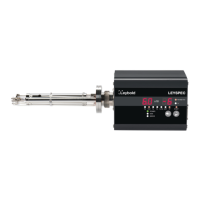37 300781172_002_C0 - 01/2019 - © Leybold
Cautions in operation
9 Cautions in operation
9.1 Operating pressure range
9.2 Degassing
The degassing mode uses an electron bombardment system for degassing.
Electron bombardment is the method of applying high voltage (300 V: LEYSPEC
view models 330 V: LEYSPEC ultra models) to the grid electrode and releasing the
gas adhering to the grid by strongly colliding thermoelectrons from the filament
towards the grid surface.
Naturally, the electrode struck by thermoelectrons will be heated corresponding to
its energy, and there will also be outgassing inside the electrode.
Pressure is not measured during degassing. Ensure that the pressure does not rise
during degassing because filament protection from pressure rise is not activated.
We recommend you monitor pressure using another vacuum gauge and, if the
pressure exceeds the measurement range, input an interlock signal.
Note that the intermediate piping can become hot during degassing.
9.3 Secondary electron multiplier (SEM) tube
Ions that have passed through the quadrupole are incident on the SEM. Ions are
incident on the metal surface on the 1st stage through the ion entrance port in the
SEM, and secondary electrons are discharged. The secondary electrons are
CAUTION:
Always use under a pressure of 1 x 10-2 Pa or less. If the pressure is higher than
1 x 10-2 Pa, the filament will burn out and the life of secondary electron multiplier
(SEM) will be extremely short.
WARNING:
Risk of burns. Be aware of high temperatures.
CAUTION:
Conduct degassing at a pressure of 1 x 10-4 Pa or less. If it is conducted in a
higher pressure region, the sensor head will be contaminated.
CAUTION:
Observe operating conditions.

